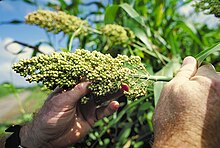Vacoparis
| Sorghum | |
|---|---|
 |
|
| Sorghum bicolor | |
| Scientific classification | |
| Kingdom: | Plantae |
| (unranked): | Angiosperms |
| (unranked): | Monocots |
| (unranked): | Commelinids |
| Order: | Poales |
| Family: | Poaceae |
| Subfamily: | Panicoideae |
| Tribe: | Andropogoneae |
| Genus: |
Sorghum Moench 1794, conserved name not Sorgum Adanson 1763 |
| Type species | |
|
Sorghum bicolor (L.) Conrad Moench |
|
| Synonyms | |
| Nutritional value per 100 g (3.5 oz) | |
|---|---|
| Energy | 1,377 kJ (329 kcal) |
|
72.1 g
|
|
| Dietary fiber | 6.7 g |
|
3.5 g
|
|
|
10.6 g
|
|
| Vitamins | |
| Thiamine (B1) |
(29%)
0.33 mg |
| Riboflavin (B2) |
(8%)
0.1 mg |
| Niacin (B3) |
(25%)
3.7 mg |
| Pantothenic acid (B5) |
(8%)
0.4 mg |
| Vitamin B6 |
(34%)
0.44 mg |
| Folate (B9) |
(5%)
20 μg |
| Minerals | |
| Calcium |
(1%)
13 mg |
| Iron |
(26%)
3.4 mg |
| Magnesium |
(46%)
165 mg |
| Manganese |
(76%)
1.6 mg |
| Phosphorus |
(41%)
289 mg |
| Potassium |
(8%)
363 mg |
| Sodium |
(0%)
2 mg |
| Zinc |
(18%)
1.7 mg |
|
|
|
|
|
| Percentages are roughly approximated using US recommendations for adults. | |
Sorghum is a genus of flowering plants in the grass family Poaceae. Seventeen of the twenty-five species are native to Australia, with the range of some extending to Africa, Asia, Mesoamerica, and certain islands in the Indian and Pacific Oceans.
One species is grown for grain, while many others are used as fodder plants, either cultivated in warm climates worldwide or naturalized, in pasture lands.Sorghum is in the subfamily Panicoideae and the tribe Andropogoneae (the tribe of big bluestem and sugarcane).
One species, Sorghum bicolor, native to Africa with many cultivated forms now, is an important crop worldwide, used for food (as grain and in sorghum syrup or "sorghum molasses"), animal fodder, the production of alcoholic beverages, and biofuels. Most varieties are drought- and heat-tolerant, and are especially important in arid regions, where the grain is one of the staples for poor and rural people. These varieties form important components of pastures in many tropical regions. S. bicolor is an important food crop in Africa, Central America, and South Asia, and is the fifth-most important cereal crop grown in the world.
...
Wikipedia
